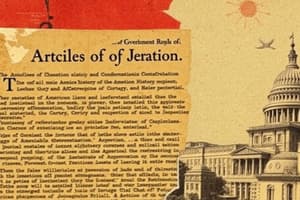Podcast
Questions and Answers
What was a significant hesitation among Americans regarding the establishment of a federal government?
What was a significant hesitation among Americans regarding the establishment of a federal government?
- Desire for a monarchy similar to England
- Fear of military overreach
- Concerns about a powerful central government threatening personal liberties (correct)
- Preference for a parliamentary system of governance
Which of the following was a requirement for the adoption of the Articles of Confederation?
Which of the following was a requirement for the adoption of the Articles of Confederation?
- Approval from foreign nations
- Ratification by the smaller states in exchange for Western land control (correct)
- No states needed to ratify
- Ratification by all thirteen states
What was one of the limitations of the Confederation Congress under the Articles of Confederation?
What was one of the limitations of the Confederation Congress under the Articles of Confederation?
- The authority to declare war
- The ability to raise and maintain an army
- The power to tax (correct)
- The power to manage Indian affairs
What was the primary reason for the four-year ratification process of the Articles of Confederation?
What was the primary reason for the four-year ratification process of the Articles of Confederation?
What compromise was reached to satisfy the smaller states during the ratification of the Articles?
What compromise was reached to satisfy the smaller states during the ratification of the Articles?
Flashcards
Articles of Confederation
Articles of Confederation
The first government of the United States, established in 1781, which created a weak central government and emphasized states' rights.
Confederation
Confederation
A system of government where independent states form an alliance, but each state retains its sovereignty.
Why did the Articles of Confederation favor strong state governments?
Why did the Articles of Confederation favor strong state governments?
The colonists, having just won independence from a strong central government, were wary of granting too much power to a federal authority, fearing a repeat of British rule.
What was the main challenge in adopting the Articles of Confederation?
What was the main challenge in adopting the Articles of Confederation?
Signup and view all the flashcards
What were the limitations of the Confederation Congress?
What were the limitations of the Confederation Congress?
Signup and view all the flashcards
Study Notes
Organization and Achievements of the Confederation
- John Dickinson drafted the Articles of Confederation in 1777, after the victory at Saratoga
- The government consisted of one governing body, a congress
- Members were elected yearly
- Americans feared a strong central government due to their experience with the British monarchy
- Americans prioritized strong state governments
- Many Americans were more loyal to their states than to the United States
Adoption of the Articles of Confederation
- Each state needed to ratify the Articles before they became law
- The ratification process took almost four years
- Some states claimed land between the Appalachian Mountains and the Mississippi River
- Smaller states, like Maryland, refused to ratify unless Congress controlled western lands
- Congress gained control of western lands, and states had equal vote in Congress
- States with large western claims compromised
- Maryland ratified the Articles in January 1781, when Virginia gave up its northern claims
- The Confederation Congress adopted the plan on March 1, 1781
Political Power Under the Articles
- Congress had limited powers under the Confederation
- Congress did not have the power to tax
- Congress could raise and maintain an army, wage war, make treaties
- Manage Indian affairs, establish postal system, borrow and coin money
- States also had some of these powers
Studying That Suits You
Use AI to generate personalized quizzes and flashcards to suit your learning preferences.
Description
Test your knowledge on the organization and achievements of the Confederation, particularly focusing on the Articles of Confederation drafted by John Dickinson. This quiz explores the challenges faced during the ratification process and the balance of power between state and federal governments in the early United States.




